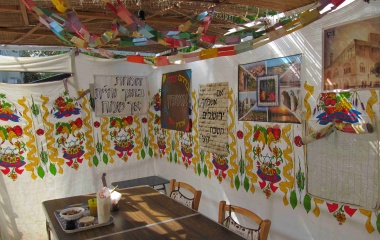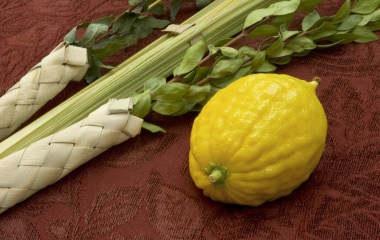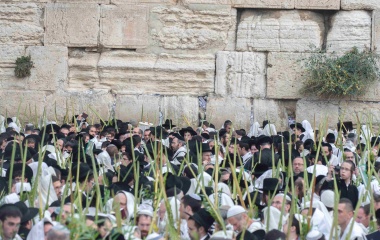
As we have studied Masechet Sukkah together, we have stressed two themes: that of simcha, joy; and that of the unity of the Jewish people. Of course, these two themes are really one—the coming together of the Jewish people is the greatest of smachot.
While these themes exist on Pesach and Shavuot—as we celebrate the forging of disparate individuals into a nation that then joined together “like one person with one heart” (Rashi Shemot 19:2) to receive the Torah—they are more pronounced on Sukkot. It is Sukkot that is z’man simchateinu[1], and in rabbinic literature, Sukkot is known simply as Chag, the holiday par excellence. And rabbinic literature is replete with the notion that the four species symbolize the different types of Jew, each of whom is incomplete without the other[2]. This theme is also present in the Sukkah itself, where the rabbis understand the verse “all citizens of Israel shall dwell in a Sukkah” to mean that “all of Israel is fit to sit in one sukkah” (Sukkah 27b).
The essence of simcha is being in—and feeling the presence of—G-d, and reaches its peak in the Temple. As it is the time of our greatest joy, more korbanot are brought on Sukkot than any other festival. The mitzvah of aliyah l’regel, to visit the Temple on Pesach, Shavuot, and Sukkot, is an expression of the mitzvah of simcha and a way of uniting people[3]. After detailing the laws of the sukkah and the arba minim, the Gemara discusses the laws of Hallel, which is said on days of joy; and then moves on to the Temple festivities, the special arava, and the celebrations surrounding the water libations.
As the masechet comes to a close, the Mishnah describes the work of the kohanim on Sukkot. As mentioned above, more sacrifices are to be offered on Sukkot than at any other time. In addition to a special offering of 70 bulls—representing each of the seventy nations of the world—two rams and fourteen sheep were brought each day, double the offerings of Pesach and Shavuot[4]; and that does not include the many sacrifices brought by the private sector.
Under normal circumstances, the kohanim were divided into twenty-four mishmarot, groupings, with each mishmar serving in the Temple once every 24 weeks—spending the rest of the time in public service, primarily that of teaching Torah (Taanit 26a). On the Yamim Tovim, all twenty four of the mishmarot were on duty in the Temple (Moed Katan 17b). While this was of great practical benefit, it was also a way of bringing the entire nation together. If we expect Jews to unite, they must see their leaders doing so.
Reflecting this, the last halacha in the last Mishnah teaches that “Yom Tov next to Shabbat, whether before (Friday) or after (Sunday) all the mishmarot divided the lechem hapanim equally”. Each Shabbat, twelve loaves of bread were baked and placed on the shulchan, the table that was housed together with the incense altar and the menorah (and where only kohanim could enter). The following week, they were divided between the entering and exiting mishmar. When Yom Tov was adjacent to Shabbat, all twenty-four mishmarot were given an equal portion. However, when Yom Tov fell on a Thursday or Monday, allowing for travel on the intervening day, the mishmar on duty would receive ten of the loaves, and those who “lingered” would divide only two amongst themselves. There was little need to arrive early or stay late—but we did not want to leave those who did empty-handed.
The Mishnah ends on a sad note, describing the punishment given to the mishmar of Bilgah, for “Miriam, the daughter of Bilgah, apostatized and married an officer of the Greek kings. When the Greeks entered the Sanctuary, she stamped with her sandal upon the altar, crying out, ‘Lukos! Lukos! (the Greek name for wolf—Rashi ), how long will you consume Israel's money? And yet, you do not stand by them in the time of oppression!’ And when the Sages heard of the incident, they made her ring immovable and blocked up her alcove” (Sukkah 56b). In explaining why both their immediate family and the entire mishmar had to suffer for the sins of this one daughter, the Gemara notes, "the speech of a child in the marketplace comes either from the father or the mother", and “woe to the wicked, and woe to his neighbour”.
The Jewish people are one, whether we are unified or not. No Jew can or should become an island unto himself, oblivious to the needs of others. Unfortunately, the rampant strife at the end of the second Temple period caused much friction and divisiveness. The tragic results are still being felt today—not surprising, as the strife amongst Jews continues unabated. We have yet to fully and properly learn Masechet Sukkah. Not a happy note on which to end Masechet Sukkah—but a realistic one.
The rabbis of the Talmud, wanting to finish the masechet on a more upbeat thought, note that if one can suffer the consequences of others, so, too, one’s actions can benefit others—“good for the righteous, good for his neighbour”. Let us strive to be good neighbours.
[1] This is based on the Biblical descriptions of the holidays, where simcha is referenced three times by Sukkot (Devarim 16:14 and 15; Vayikra 23:40), once by Shavuot (Devarim 16:11), and not at all regarding Pesach.
[2] This theme is also present at the seder, where each of the four very different children join together. However, while the lulav is a key aspect of Sukkot, the four children are a peripheral part of the seder, and the reciting of such fulfils no particular mitzvah.
[3] One who found a lost object was to declare this at the Temple and could only keep such after enough time had passed for one to go home and check if the object was missing. This large lost-and-found was another way the Temple served to unite all.
[4] As pointed out by Rabbi Menachem Leibtag, Sukkot is both the culmination of the three pilgrim festivals and of the High Holiday season—a double holiday requiring double the sacrifices.



